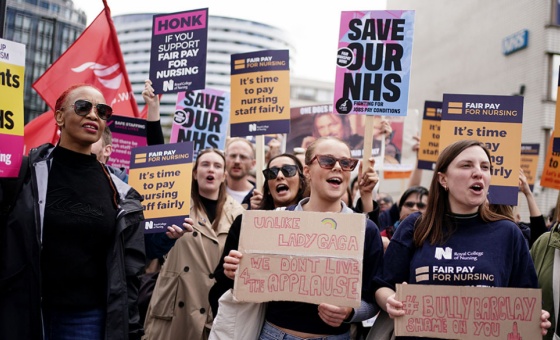This is the last article you can read this month
You can read more article this month
You can read more articles this month
Sorry your limit is up for this month
Reset on:
Please help support the Morning Star by subscribing here
THERE was a time, from the beginning to the middle of 20th century, when feminism was clearly identified with socialism, either in its reformist or revolutionary variant.
Indeed, although liberal feminism was always important (and probably dominant), both the Socialist Party (PS) and the Communist Party (PC) offered entire generations of highly influential feminists, from Alicia Moreau de Justo to Fanny Edelman.
Since the ’60s of the last century there has been, gradually, a systematic departure of feminism from socialist political positions.
Partly because of the refusal of many leftist groups to recognise the importance of a women’s liberation movement that goes far beyond trade unionism, that is, immediate demands.
The rise of Peronist influence in the Argentinian “new left” of those decades cannot be underestimated, either — an influence that carries from its beginning the mark of the most right-wing Catholicism, which does not leave much space for feminism, beyond mythologisation of Eva Peron.
But the expansion of radical feminism and its anti-class perspective also play a part. That divorce still weighs on us today.
Actually, the return of bourgeois democracy in 1983 after the military dictatorship gave rise, on the one hand, to the dominance of those currents from a wide liberal spectrum, embodied by the organisations linked to the Radical Civic Union and president Raul Alfonsin.
It was Alfonsin who consolidated this line, transforming into law an almost centennial claim of Argentine women, the divorce law.
But this transformation of Argentinian feminism into an appendage of bourgeois parties went hand in hand with the expansion of non-governmental organisations — interest groups whose main characteristic is that no matter how much they claim to be independent from political life and the state, they depend on contracts, financing and fluid relations with the instituted power.
It is this world of small organisations that declare themselves exclusively “feminist” and that claim to have no other interest, but that are solidly linked to the big bosses’ parties (especially Peronism) which was to be an instrument that would undoubtedly become a very important centre of political power, by gathering at the National Women’s Meeting.
This centre, only apparently empty of politics, dominated at first by liberal and radical feminists — supporters of the Radical Civic Union — would grow rapidly, multiplying the numbers of its convocation.
If the first meetings brought together a few dozen militants of the most diverse political content (radicals, liberals, “esoteric” humanists, etc) and, basically, from Buenos Aires, as we move forward to the ’90s, the number of participants multiplied by thousands, and even tens of thousands, reaching more than several hundred thousand women throughout the country in the most massive cases.
At the same time, the dominance of Peronism and the Catholic Church took hold, along with some influence from the Revolutionary Communist Party (Maoism).
The Trotskyists and Guevarists (the most important factions of the Argentine left, in the wake of the progressive dissolution of the Communist Party) only approached the National Women’s Meeting, compelled by its massiveness.
Thus groups of women arose linked to these currents, however most of them do not declare themselves as feminists.
In such circumstances, we reached the most serious political crisis in Argentinian history so far, in December 2001, when riots and civil unrest against the government and the dire economic situation erupted across the country.
The consequences of this political crisis, which in Argentinian folklore is called Argentinazo, produced an important transformation in this picture.
As a result of the vacuum that socialist feminism had left in our country, at least since the ’60s, the “left” positions in the feminist movement were occupied by more or less radicalised variants of liberal bourgeois feminism.
In other words, the fracture between class and gender that occurred then, not only was not restored but, on the contrary, it deepened, because those who embodied it better — the Socialist Party and the Communist Party — marched towards political ostracism and/or integration into bourgeois politics and because the new dominant currents of the left (Maoism, Guevarism and Trotskyism) rejected feminism for its “bourgeois” content.
Consequently, small groups gained strength: they defined themselves as “autonomists,” a vague concept that simply reflects the lack of a unifying centre for political action, one of the most notable consequences of the Argentinazo.
These groups also grew due to the shameful association with the government of Carlos Menem (considered “neoliberal”), which even organised a “women’s cabinet” where several notable old guard feminists took part.
These small groups, whose ideology oscillates between Michel Foucault and Julia Kristeva, rabidly anti-Marxist and anti-party, who would be summoned by Kirchnerism well into the 21st century, began to address the women's question with a discourse of “inclusion” and “empowerment” that in reality announced the beginning of postmodernism and introduced the politics of “diversity” into the feminist movement.
Following Ernesto Laclau’s suggestions, Kirchnerism summoned each sector of Argentinian society according to the speech that each one of them wanted to hear, in such a way that the government remained as the articulator of a vast social movement, plagued by contradictions as the great demiurge jumps, as he alternately passes from one place to another, while making minimal concessions.
Thus, feminism became a place of agglutination: it is no longer of women, but of “native women” (aboriginal population), diversities (lesbians, bisexuals, gay men, non-binaries, etc) and trans (transvestites, transsexuals and transgenders).
As if that weren’t enough, the “gordxs” (“fat people,” using “inclusive language”), the “marronas” (supposedly “mestizo” population) and “the disabled” (people with some kind of physical disability) were also distinguished there.
This explosion of meaning had an impact on the National Women’s Meeting, which would now be called according to that summation we are talking about. This is the triumph of “queer feminism.”
This explosion of identities has not only not benefited women, but, on the contrary, has allowed other “collectives” to conquer their demands without much effort, as with the Gender Identity Law.
However, the women have not obtained anything. Despite having starred in a mass movement against femicides, Ni una menos (“Not one [woman] less”), no serious measures have been taken to address the fact that a woman is murdered every 30 hours.
In fact, the dominance that Kirchnerism has exercised and exercises over the Ni una menos since its inception has dismantled any possibility of real action.
It has become a simple electoral apparatus, which only moves when it comes to criticising and attacking the enemies of Kirchnerism.
The same can be said of the gigantic and millionaire mobilisations for abortion rights.
Kirchnerism ruled 12 years in a row — first under Nestor Kirchner, then under Cristina Fernandez.
Never, throughout the period of Kirchnerism could a Bill on abortion rights be discussed, not even the one sponsored by their own supporters.
It was Mauricio Macri who made possible the debate on the issue in Congress, which was not approved because Kirchnerism did not compel their representatives in the National Senate to vote for the project.
Within the government there coexist both supporters and opponents of abortion rights — but the determining weight is always with the church, a weight reinforced by the role of Pope Francis in Argentinian politics.
The current president, Alberto Fernandez, who put the issue in the foreground on his electoral platform, has subsequently kept it under lock and key so as not to upset the Supreme Pontiff.
That doesn’t stop the officialism from boosting other aspects of queer politics like surrogacy, as well as “fighting trafficking” while seeking to legalise prostitution.
What has the left done in all this time? After giving feminism to the liberal bourgeois currents during the ’90s, they ignored the problem once again, until Ni una menos and the fight for free, legal abortion on demand sprang onto the scene.
At that time, those who had denied feminism as “bourgeois” became massively attracted to the most decomposed bourgeois feminism, “queer feminism.”
They adopted even their most unpleasant tics, from “inclusive language” (replacing the “o” because it denotes “masculine,” with the “e”, which would be “neutral”), to expressions that erase women, such as “pregnant people” and similar phrases.
It is notorious that this left — grouped in the FIT-U (Left Front and Workers - Unity) bringing together the main Trotskyist and Guevarist organisations — has abandoned (not only in this field) all class politics, folding completely to the great Argentinian bourgeois party (Peronism, of which Kirchnerism is just its current face) and to queer politics.
It is necessary to return to the relationship between class and gender, that is, a class perspective of feminism. That is socialist feminism.
We must reject the “queer feminism” as a bourgeois outpost, recover for women the movement that we have built and endow it with a socialist perspective, against particularism and “diversity.”
Few groups in Argentina position themselves against the worldwide wave of “erasure of women,” against this new imposition of patriarchy and the commodification of female body by legalisation of prostitution, surrogacy and other mechanisms like that.
A recently created party, Razon y Revolucion, where I am an activist, has a feminist organisation, Trece Rosas, that finds itself alone struggling to take back feminism for socialism and the working class.










